Our own Clasky wrote this white paper we hope sheds some light on the Green vs. the White Phosphor discussion. Enjoy.
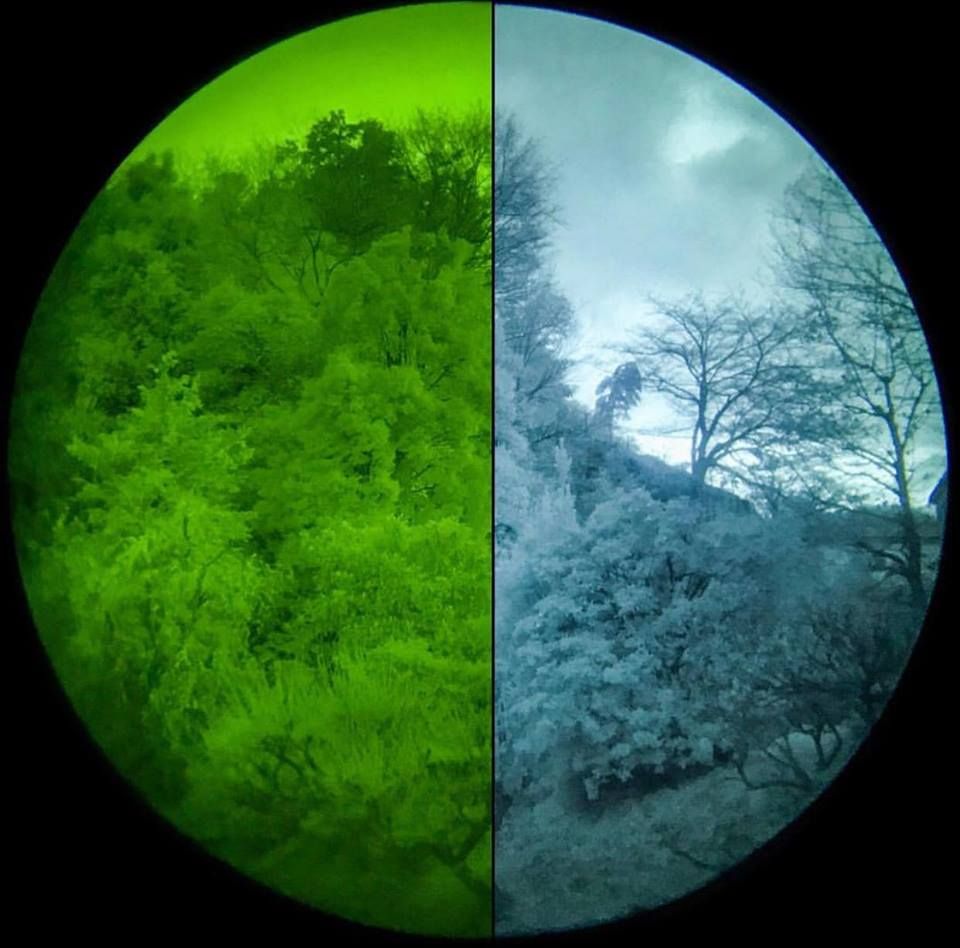
We are often asked about the difference between Green and White Phosphor Image Intensifier Tubes. “Is white really worth the extra money?” The answer is pretty subjective, but I always tell people “it depends.” It depends on your mission and it depends on your budget. White phosphor image tubes are the latest evolution in the development of analog night vision technology used by U.S. Special Operations Forces (SOF). There are other night vision developments that perform certain tasks really well and other tasks not-so-well. Some will argue this or that is better, and manufacturers will tell you their product is always superior. All we can say is there are certain technologies currently in use by the most elite national assets in the U.S. Arsenal, and certain technologies that are not in use by said units. Currently, all night vision image intensifier tubes bought for combat use by USSOCOM, JSOC, USASOC, NSW, MARSOC, and any other US SOF unit, are L-3 Filmless White Phosphor. But, that doesn’t necessarily mean it is the right choice for every buyer.
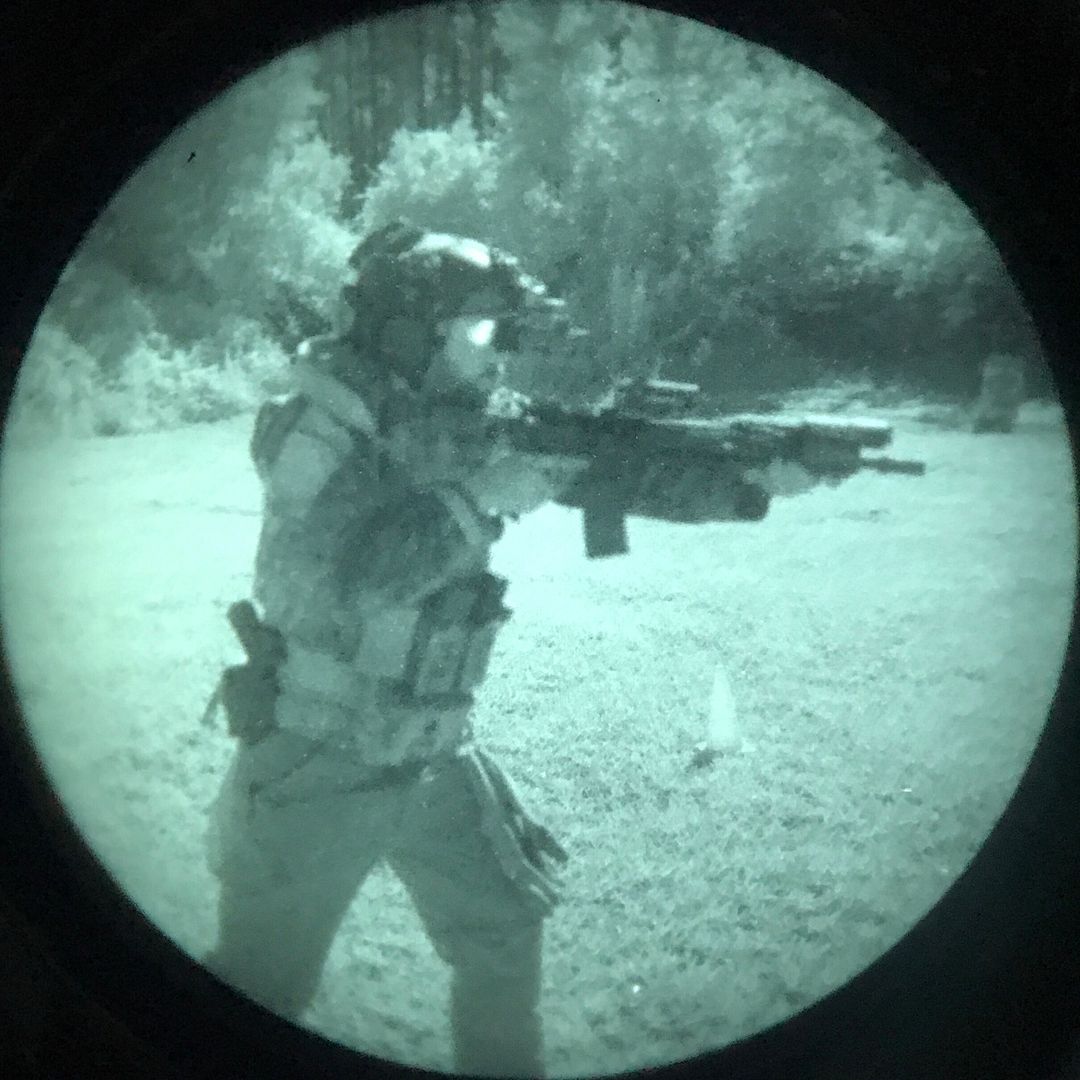
TNVC/Night Goggles and U.S. Navy Vet, Sam, participating in night vision training in Florida (L-3 Filmless White Phosphor image).
What is white phosphor? To understand WP, we first need to establish a basic understanding of how night vision works and how it came to be in its current configuration. Now, I’m not going to sit here and delve into minutia of science and write a doctoral thesis on this technology. Do I look like I work in a lab with beakers and test tubes? Let’s be honest: most of us wouldn’t have the patience to read it all, let alone understand it. So let’s break this down into layman’s terms. Technology-aided night vision has been around in one form or another since World War II. The original night vision required an active near-infrared light source in order to provide an image. The allies placed giant spotlight-type illuminators on tanks that provided a near-IR illumination observed by the tank crew through a special battery-operated scope. The Nazis did the same, but also developed “miniaturized” versions that were man-portable. The ZG1229 Vampir was an active infrared night vision device that was mounted to the Sturmgewehr 44 assault rifle. It featured a large scope with a direct mounted infrared illuminator on top. The unit was powered by a large battery worn in a backpack by the soldier. All of these units were large, clumsy, and required active near-IR illuminators that could be seen as red lights from downrange. The US copied the “miniaturized” Vampir and deployed it against North Korea in the early 50’s during the Korean War. The overall configuration didn’t change much, and it looked just as ridiculous on top of an M3 Carbine as it did on an STG44.
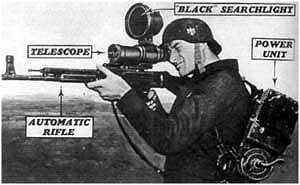
German Wehrmacht with Vampir (Gen0) Night Vision Scope. The unwieldy system would limit the soldier's ability to carry other field gear due to the "Ghostbusters Proton Pack" backpack that carried the systems' battery.

German ZG 1229 Vampir Scope with Active Near-Infrared Illuminator.
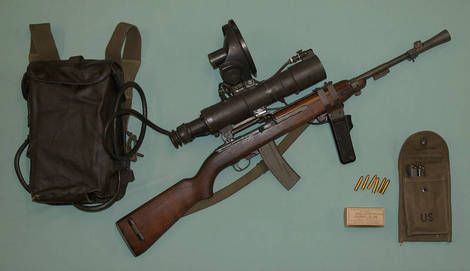
U.S. M3 Carbine with integrated near-infrared sight system. Only about 2100 were made. The M3 had no open iron sights and was built specifically for night vision scopes.
The Vietnam War saw the development and employment of the first true “starlight scopes” that did not require active IR that could be seen from downrange. These giant scopes, such as the PVS-2, were issued to SOF and LRRP units and provided an advantage, though limited by the dense foliage of Southeast Asia, to US troops. The United States saw continual development of night vision technology throughout the Vietnam War and on through the 80’s and 90’s. But technology without the means to properly test it, will always slow development. The original night vision devices of WWII and Vietnam were few and far between, only being issued to select specialized units. They were giant leaps forward in battlefield science, but usable service data was hard to collect due to the extremely limited fielding of such devices. Most Commanders paid little mind to night vision technology. While the continual development of night vision goggles and scopes went on through the 80’s and 90’s, a slightly different slant to the problem occurred: conflicts were too short to provide any good data on how to improve the technology.
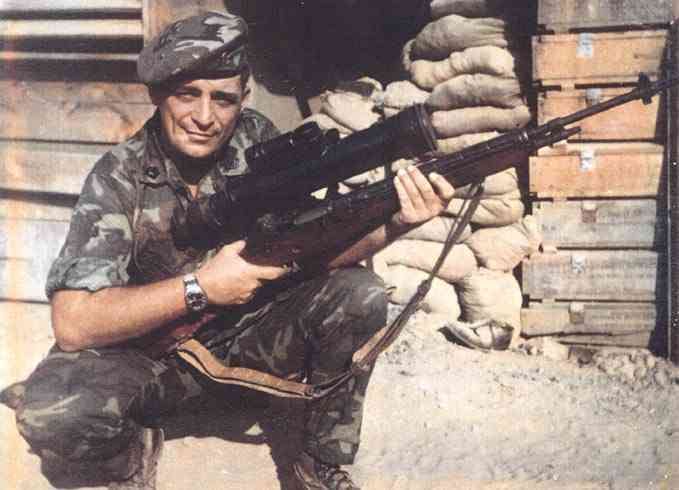
U.S. Army 9th Infantry Division sniper, Ron Fillingham,[/size=2][/size=3] with Starlight Scope-equipped M-14 Rifle in Vietnam.
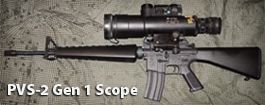
M16A1 Rifle fitted with AN/PVS-2 Starlight Scope, circa early 1980's.
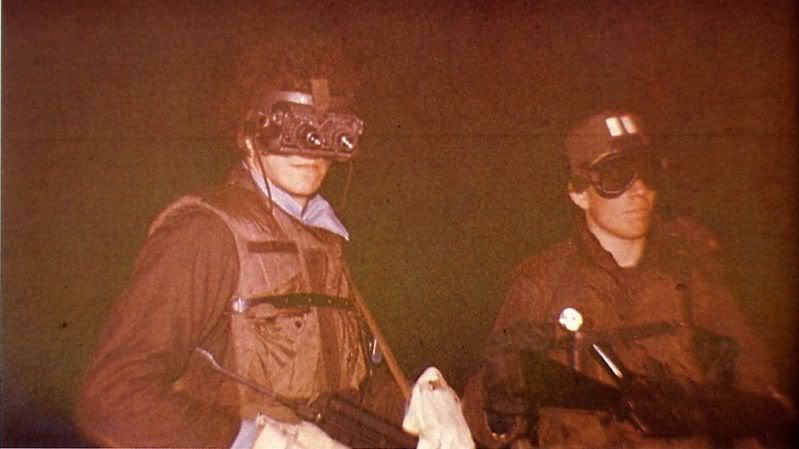
U.S. Army 1st SFOD-D Operator wearing AN/PVS-5 Night Vision Goggles at Desert One, during Operation Eagle Claw in 1980.
It wasn’tuntil the Global War on Terror kicked off that the U.S. entered into a prolonged conflict where our combat systems could be truly tested and evaluated. It’s ironic how Usama Bin Ladin’s heinous attack was the impetus for us to learn how to kill his kind really, really effectively. The opening years of the war saw the wholesale destruction of Muslim Jihadist, the likes of which had never been seen in history. The Taliban and AQ fighters didn’t know what hit them – literally,because of night vision technology. They had no idea they could be seen in the darkness of night, let alone targeted, engaged, and destroyed. It was a beautiful time in Allied military history. We could literally lay waste to thousands of enemy fighters at a time,because of technology. And night vision was the primary technology that made the bad guys too scared to sleep.

Assaulters from a U.S. Army Special Mission Unit, wearing ANVIS-9 Night Vision Goggles prior to operations in Iraq.
Since the advent of Starlight Scopes (Gen1) in the 1960’s, image intensifiers have produced green images. This comes from the color of the phosphor screen. The phosphor screen (sit tight for the explanation) can be any color. But, green is the most visible color to the human eye. So, green was the natural choice for the night vision image. This worked quite well for decades. But the law of technology and warfare is “innovate or die.” After several years of decidedly one-sided fighting in Afghanistan,Allied forces began meeting pointed resistance at night. It’s one thing for enemy fighters to blindly fire into the night because they are getting engaged. It’s something else entirely when they start providing effective fire back at you. This WTF moment was brought to us courtesy of battlefield pick-up NVG’s and Chechen fighters bringing cheap or black market goggles into the fold.
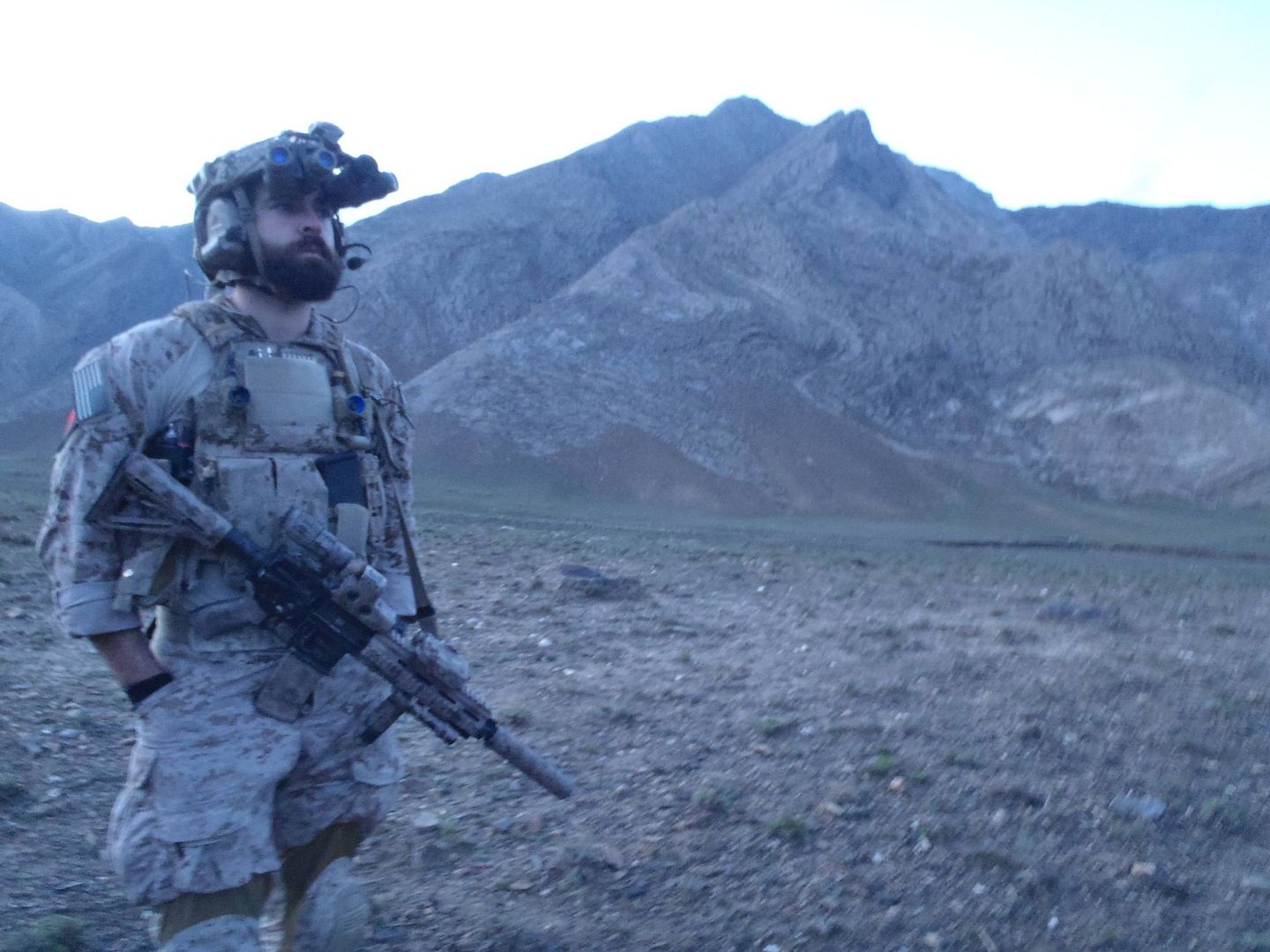
U.S. Navy DEVGRU Operator, Brett 'Shady' Shadle, wearing GPNVG-18 Night Vision Goggles in Afghanistan. Brett was tragically killed in a parachute training accident in AZ in 2013.
Now, let’s step back and talk about some night vision truths. Night Vision isn’t magic. It may seem that way, but night vision is an image intensification technology. It requires some amount of ambient light to amplify. If you take the latest/greatest image tubes,issued to Tier1 Assets, and try to look through them in an absolute pitch black environment, you will not see any image except for scintillation – electronic signal trying to make something out of nothing. Today’s tubes can do a whole lot more with a whole lot less, but they still need some ambient light to work with. Lucky for us, there are relatively fewer environments that contain zero light. But, the more light you have, the better your image will be. And when you are in darker environments, you often want to supplement your light capability with artificial infrared illumination. IR illuminators work like flashlights for your night vision goggles. They allow you to use night vision in super low light / no-light conditions. But, they can be seen by anyone with night vision. When you’re used to owning the night, it’s pretty shocking when your IR lasers and illuminators start working against you as they draw enemy fire. That’s when SOF operators started asking for the ability to see into darker environments before
needing to supplement with artificial IR.
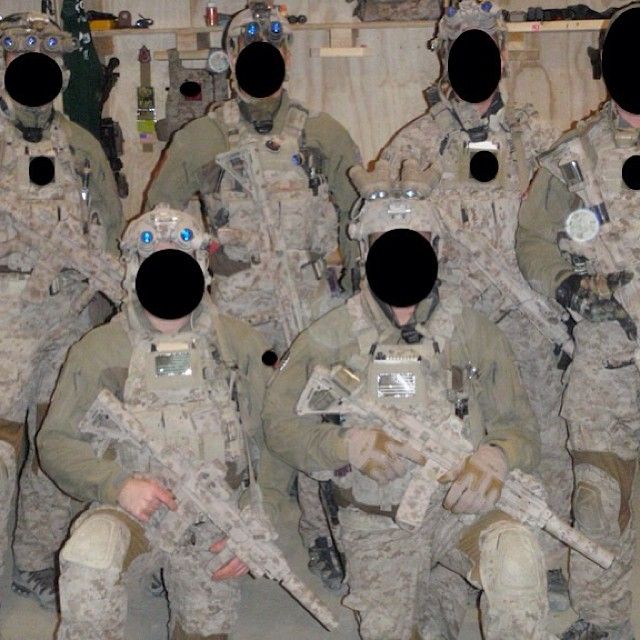
U.S. Navy DEVGRU Operators prior to combat operations in Afghanistan.
This led to the development of white phosphor, and just as importantly – filmless image tubes. While green may be the most visible color to the human eye, white is the brightest color in the visible light spectrum. Simply changing the color of the phosphor screen from green to white provided an immediate jump in image brightness. White images also proved more universally acceptable for human eyes during prolonged use. But, the prospect of killing more jihadists drove the train right past that station into filmless technology. This brings us to our next tangent: how image intensifier tubes work. Traditional Gen3image tubes are thin-filmed. Thin filmis an ion barrier that protects the tube from destroying itself during function. Photons (light energy) are converted into electrons (positive and negatively-charged) as they pass through the photocathode. The negatively charged electrons pass through the micro channel plate (MCP), where they are multiplied… a lot. The many, many more electrons that come out the other side of the MCP are splashed up on the phosphor screen, which converts them back into photons (a lot more of them). This becomes the light-amplified image you see. But, the positively charged electrons are repulsed by the negatively charged electrons back at the photocathode. These travel in the opposite direction and would impact/destroy the photocathode if not for the thin film ion barrier. While this is good, and the night vision image seen by the operator is phenomenal, it is handicapped by the thin film. Basically,the thin film blocks a little under 50% of the light that could be gathered to begin with. But, without it, the tube would be quickly destroyed.
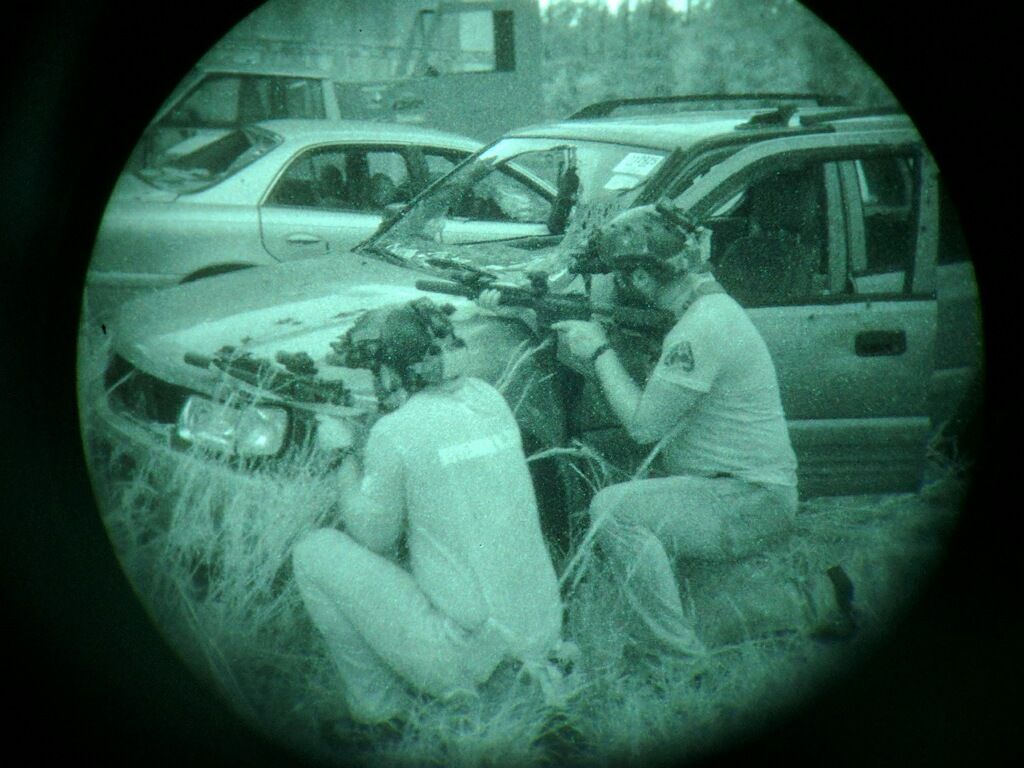
TNVC employees, Sam and Don participate in night vision training in Florida (L-3 Filmless White Phosphor image)
The geniuses at L-3 Warrior Systems developed and patented filmless technology. While we are not at liberty to fully discuss the details on how this is achieved, the gist is that the tube can gather way more light, which is then amplified even more, all while retaining a minimum 10,000 hours powered tube life. Harris(formerly ITT Exelis) also makes WP tubes, but theirs are still thin-filmed. So, while the image is still brighter than a thin-filmed green tube, they will not provide the same brightness levels or resolution as a filmless tube.
White phosphor is an insanely potent technology that provides a clear advantage over green for the warfighter. But, does it make green obsolete? The answer is no. While white does provide a distinct advantage, it is not perfect. The white image can sometimes be too bright in higher light conditions. While these conditions are not the primary operational environment for night vision, they do occur. If you live or work in an urban or suburban area, you will have an abundance of man-made ambient light at night. This amount of light will not always provide you enough illumination to operate safely, so night vision is the answer. But, the over-sensitivity of white + filmless, can sometimes create a glowing halo effect. This is when you want to turn down the gain on your goggle, or use light-limiting objective covers. But overall, green may be a more viable option for these areas of operations. That said, the US SOF community is only purchasing white phosphor night vision right now. They still have green in inventory, but it is being phased out as older goggles are retired.
But again,just because the Navy SEALs are running white phosphor, doesn’t mean it’s what you need. While it certainly has a high “chicks dig it” factor, WP is expensive. You will generally spend $800+ more per WP tube. Yes, there are cheaper WP tubes, but you need to ask yourself why they are cheaper. Without getting into the nitty gritty of tube differences, let’s suffice to say that not all tubes are created equal. Some pass muster at the factory, and others don’t (they are sold at a discount to various dealers to recoup monies spent in production). There are still plenty of SOF units and infantry kids stacking the bodies of jihadists across the globe, through green screen. There is absolutely nothing wrong with green and a lot more bad guys have met their virgins as a result of operators armed with green night vision than white. White is certainly great if you can afford it in your budget. But that is the hinge point of your decision. Does your budget allow for the white upgrade?
Personally,I tell people this: if you need to uncomfortably stretch your budget to afford white, stick with green. Save the extra money for mounts, lasers, helmets, ammo, 401K, etc. Night vision requires a lot of different accessories to work properly. But, if you have the extra money laying around, then get white. Having or not having one or the other willnot be the deciding factor in your mission success. Both white and green are phenomenal technologies that have, and continue to serve our warfighters and LEO’s well. We can’t tell you to get one or the other. But hopefully, you now have abetter grasp on the technology to make a more informed decision (or at least were entertained while sitting on the toilet). Either way, keep your powder dry and be safe.

We are often asked about the difference between Green and White Phosphor Image Intensifier Tubes. “Is white really worth the extra money?” The answer is pretty subjective, but I always tell people “it depends.” It depends on your mission and it depends on your budget. White phosphor image tubes are the latest evolution in the development of analog night vision technology used by U.S. Special Operations Forces (SOF). There are other night vision developments that perform certain tasks really well and other tasks not-so-well. Some will argue this or that is better, and manufacturers will tell you their product is always superior. All we can say is there are certain technologies currently in use by the most elite national assets in the U.S. Arsenal, and certain technologies that are not in use by said units. Currently, all night vision image intensifier tubes bought for combat use by USSOCOM, JSOC, USASOC, NSW, MARSOC, and any other US SOF unit, are L-3 Filmless White Phosphor. But, that doesn’t necessarily mean it is the right choice for every buyer.

TNVC/Night Goggles and U.S. Navy Vet, Sam, participating in night vision training in Florida (L-3 Filmless White Phosphor image).
What is white phosphor? To understand WP, we first need to establish a basic understanding of how night vision works and how it came to be in its current configuration. Now, I’m not going to sit here and delve into minutia of science and write a doctoral thesis on this technology. Do I look like I work in a lab with beakers and test tubes? Let’s be honest: most of us wouldn’t have the patience to read it all, let alone understand it. So let’s break this down into layman’s terms. Technology-aided night vision has been around in one form or another since World War II. The original night vision required an active near-infrared light source in order to provide an image. The allies placed giant spotlight-type illuminators on tanks that provided a near-IR illumination observed by the tank crew through a special battery-operated scope. The Nazis did the same, but also developed “miniaturized” versions that were man-portable. The ZG1229 Vampir was an active infrared night vision device that was mounted to the Sturmgewehr 44 assault rifle. It featured a large scope with a direct mounted infrared illuminator on top. The unit was powered by a large battery worn in a backpack by the soldier. All of these units were large, clumsy, and required active near-IR illuminators that could be seen as red lights from downrange. The US copied the “miniaturized” Vampir and deployed it against North Korea in the early 50’s during the Korean War. The overall configuration didn’t change much, and it looked just as ridiculous on top of an M3 Carbine as it did on an STG44.

German Wehrmacht with Vampir (Gen0) Night Vision Scope. The unwieldy system would limit the soldier's ability to carry other field gear due to the "Ghostbusters Proton Pack" backpack that carried the systems' battery.

German ZG 1229 Vampir Scope with Active Near-Infrared Illuminator.

U.S. M3 Carbine with integrated near-infrared sight system. Only about 2100 were made. The M3 had no open iron sights and was built specifically for night vision scopes.
The Vietnam War saw the development and employment of the first true “starlight scopes” that did not require active IR that could be seen from downrange. These giant scopes, such as the PVS-2, were issued to SOF and LRRP units and provided an advantage, though limited by the dense foliage of Southeast Asia, to US troops. The United States saw continual development of night vision technology throughout the Vietnam War and on through the 80’s and 90’s. But technology without the means to properly test it, will always slow development. The original night vision devices of WWII and Vietnam were few and far between, only being issued to select specialized units. They were giant leaps forward in battlefield science, but usable service data was hard to collect due to the extremely limited fielding of such devices. Most Commanders paid little mind to night vision technology. While the continual development of night vision goggles and scopes went on through the 80’s and 90’s, a slightly different slant to the problem occurred: conflicts were too short to provide any good data on how to improve the technology.

U.S. Army 9th Infantry Division sniper, Ron Fillingham,[/size=2][/size=3] with Starlight Scope-equipped M-14 Rifle in Vietnam.

M16A1 Rifle fitted with AN/PVS-2 Starlight Scope, circa early 1980's.

U.S. Army 1st SFOD-D Operator wearing AN/PVS-5 Night Vision Goggles at Desert One, during Operation Eagle Claw in 1980.
It wasn’tuntil the Global War on Terror kicked off that the U.S. entered into a prolonged conflict where our combat systems could be truly tested and evaluated. It’s ironic how Usama Bin Ladin’s heinous attack was the impetus for us to learn how to kill his kind really, really effectively. The opening years of the war saw the wholesale destruction of Muslim Jihadist, the likes of which had never been seen in history. The Taliban and AQ fighters didn’t know what hit them – literally,because of night vision technology. They had no idea they could be seen in the darkness of night, let alone targeted, engaged, and destroyed. It was a beautiful time in Allied military history. We could literally lay waste to thousands of enemy fighters at a time,because of technology. And night vision was the primary technology that made the bad guys too scared to sleep.

Assaulters from a U.S. Army Special Mission Unit, wearing ANVIS-9 Night Vision Goggles prior to operations in Iraq.
Since the advent of Starlight Scopes (Gen1) in the 1960’s, image intensifiers have produced green images. This comes from the color of the phosphor screen. The phosphor screen (sit tight for the explanation) can be any color. But, green is the most visible color to the human eye. So, green was the natural choice for the night vision image. This worked quite well for decades. But the law of technology and warfare is “innovate or die.” After several years of decidedly one-sided fighting in Afghanistan,Allied forces began meeting pointed resistance at night. It’s one thing for enemy fighters to blindly fire into the night because they are getting engaged. It’s something else entirely when they start providing effective fire back at you. This WTF moment was brought to us courtesy of battlefield pick-up NVG’s and Chechen fighters bringing cheap or black market goggles into the fold.

U.S. Navy DEVGRU Operator, Brett 'Shady' Shadle, wearing GPNVG-18 Night Vision Goggles in Afghanistan. Brett was tragically killed in a parachute training accident in AZ in 2013.
Now, let’s step back and talk about some night vision truths. Night Vision isn’t magic. It may seem that way, but night vision is an image intensification technology. It requires some amount of ambient light to amplify. If you take the latest/greatest image tubes,issued to Tier1 Assets, and try to look through them in an absolute pitch black environment, you will not see any image except for scintillation – electronic signal trying to make something out of nothing. Today’s tubes can do a whole lot more with a whole lot less, but they still need some ambient light to work with. Lucky for us, there are relatively fewer environments that contain zero light. But, the more light you have, the better your image will be. And when you are in darker environments, you often want to supplement your light capability with artificial infrared illumination. IR illuminators work like flashlights for your night vision goggles. They allow you to use night vision in super low light / no-light conditions. But, they can be seen by anyone with night vision. When you’re used to owning the night, it’s pretty shocking when your IR lasers and illuminators start working against you as they draw enemy fire. That’s when SOF operators started asking for the ability to see into darker environments before
needing to supplement with artificial IR.

U.S. Navy DEVGRU Operators prior to combat operations in Afghanistan.
This led to the development of white phosphor, and just as importantly – filmless image tubes. While green may be the most visible color to the human eye, white is the brightest color in the visible light spectrum. Simply changing the color of the phosphor screen from green to white provided an immediate jump in image brightness. White images also proved more universally acceptable for human eyes during prolonged use. But, the prospect of killing more jihadists drove the train right past that station into filmless technology. This brings us to our next tangent: how image intensifier tubes work. Traditional Gen3image tubes are thin-filmed. Thin filmis an ion barrier that protects the tube from destroying itself during function. Photons (light energy) are converted into electrons (positive and negatively-charged) as they pass through the photocathode. The negatively charged electrons pass through the micro channel plate (MCP), where they are multiplied… a lot. The many, many more electrons that come out the other side of the MCP are splashed up on the phosphor screen, which converts them back into photons (a lot more of them). This becomes the light-amplified image you see. But, the positively charged electrons are repulsed by the negatively charged electrons back at the photocathode. These travel in the opposite direction and would impact/destroy the photocathode if not for the thin film ion barrier. While this is good, and the night vision image seen by the operator is phenomenal, it is handicapped by the thin film. Basically,the thin film blocks a little under 50% of the light that could be gathered to begin with. But, without it, the tube would be quickly destroyed.

TNVC employees, Sam and Don participate in night vision training in Florida (L-3 Filmless White Phosphor image)
The geniuses at L-3 Warrior Systems developed and patented filmless technology. While we are not at liberty to fully discuss the details on how this is achieved, the gist is that the tube can gather way more light, which is then amplified even more, all while retaining a minimum 10,000 hours powered tube life. Harris(formerly ITT Exelis) also makes WP tubes, but theirs are still thin-filmed. So, while the image is still brighter than a thin-filmed green tube, they will not provide the same brightness levels or resolution as a filmless tube.
White phosphor is an insanely potent technology that provides a clear advantage over green for the warfighter. But, does it make green obsolete? The answer is no. While white does provide a distinct advantage, it is not perfect. The white image can sometimes be too bright in higher light conditions. While these conditions are not the primary operational environment for night vision, they do occur. If you live or work in an urban or suburban area, you will have an abundance of man-made ambient light at night. This amount of light will not always provide you enough illumination to operate safely, so night vision is the answer. But, the over-sensitivity of white + filmless, can sometimes create a glowing halo effect. This is when you want to turn down the gain on your goggle, or use light-limiting objective covers. But overall, green may be a more viable option for these areas of operations. That said, the US SOF community is only purchasing white phosphor night vision right now. They still have green in inventory, but it is being phased out as older goggles are retired.
But again,just because the Navy SEALs are running white phosphor, doesn’t mean it’s what you need. While it certainly has a high “chicks dig it” factor, WP is expensive. You will generally spend $800+ more per WP tube. Yes, there are cheaper WP tubes, but you need to ask yourself why they are cheaper. Without getting into the nitty gritty of tube differences, let’s suffice to say that not all tubes are created equal. Some pass muster at the factory, and others don’t (they are sold at a discount to various dealers to recoup monies spent in production). There are still plenty of SOF units and infantry kids stacking the bodies of jihadists across the globe, through green screen. There is absolutely nothing wrong with green and a lot more bad guys have met their virgins as a result of operators armed with green night vision than white. White is certainly great if you can afford it in your budget. But that is the hinge point of your decision. Does your budget allow for the white upgrade?
Personally,I tell people this: if you need to uncomfortably stretch your budget to afford white, stick with green. Save the extra money for mounts, lasers, helmets, ammo, 401K, etc. Night vision requires a lot of different accessories to work properly. But, if you have the extra money laying around, then get white. Having or not having one or the other willnot be the deciding factor in your mission success. Both white and green are phenomenal technologies that have, and continue to serve our warfighters and LEO’s well. We can’t tell you to get one or the other. But hopefully, you now have abetter grasp on the technology to make a more informed decision (or at least were entertained while sitting on the toilet). Either way, keep your powder dry and be safe.

